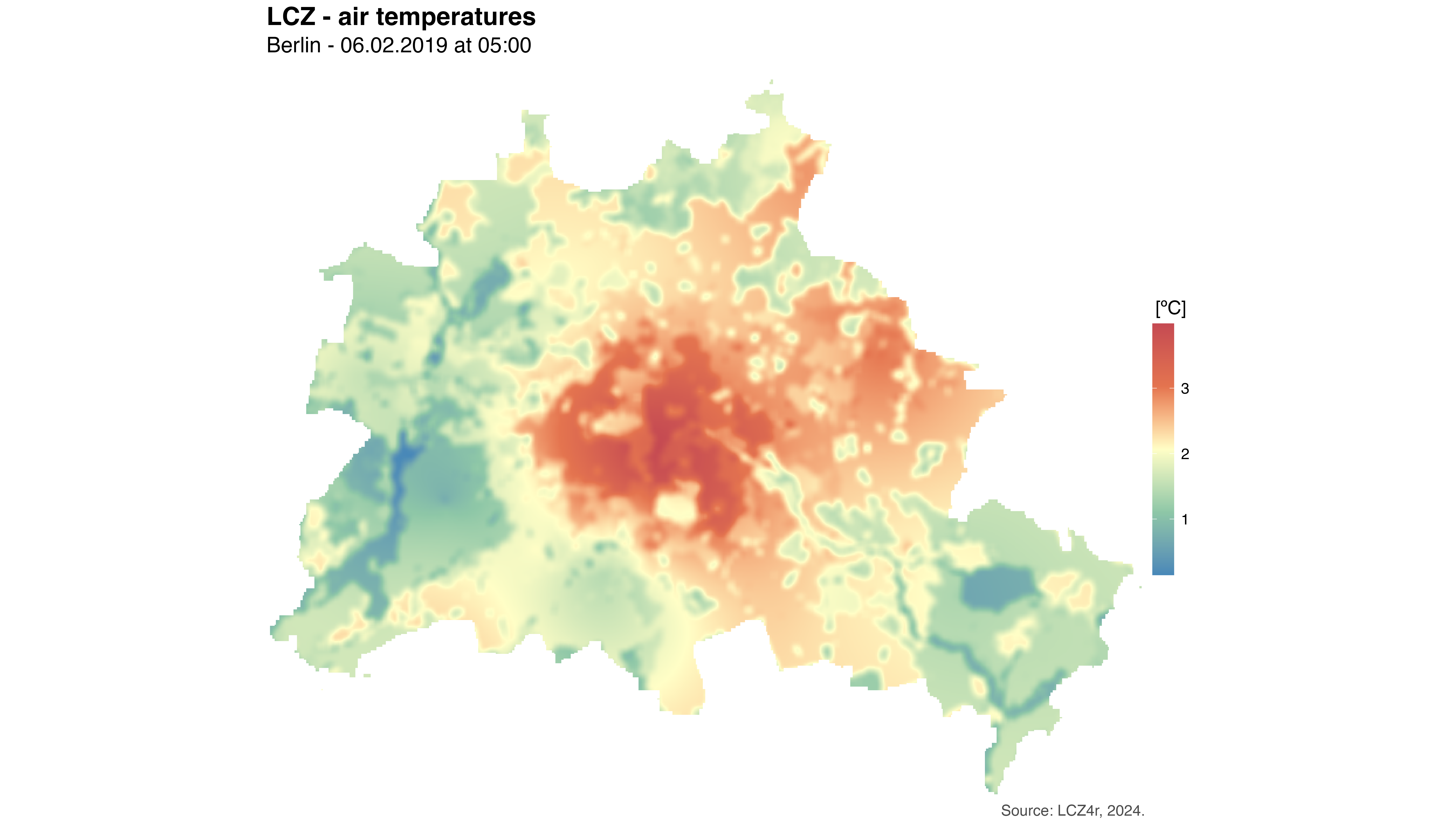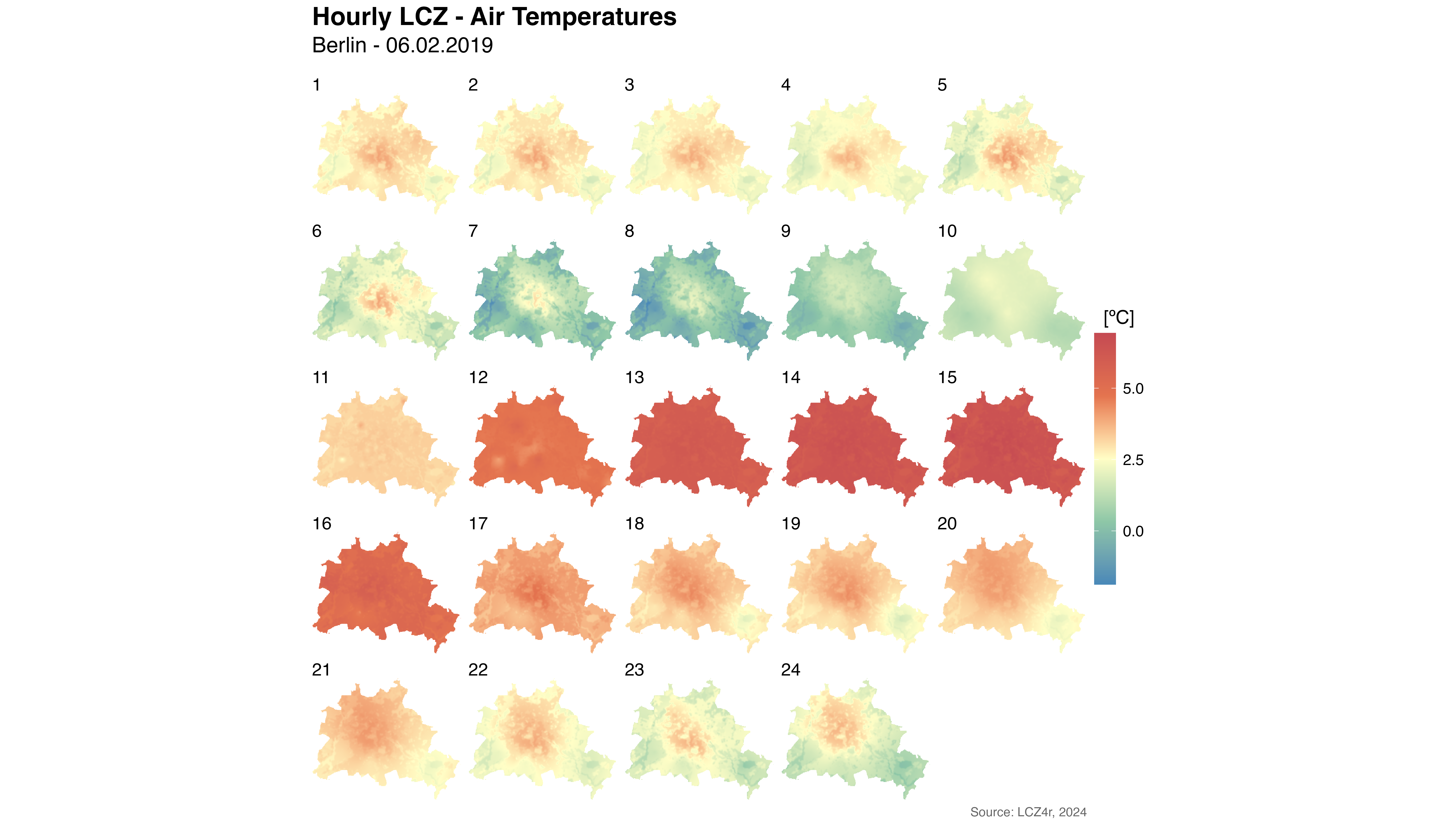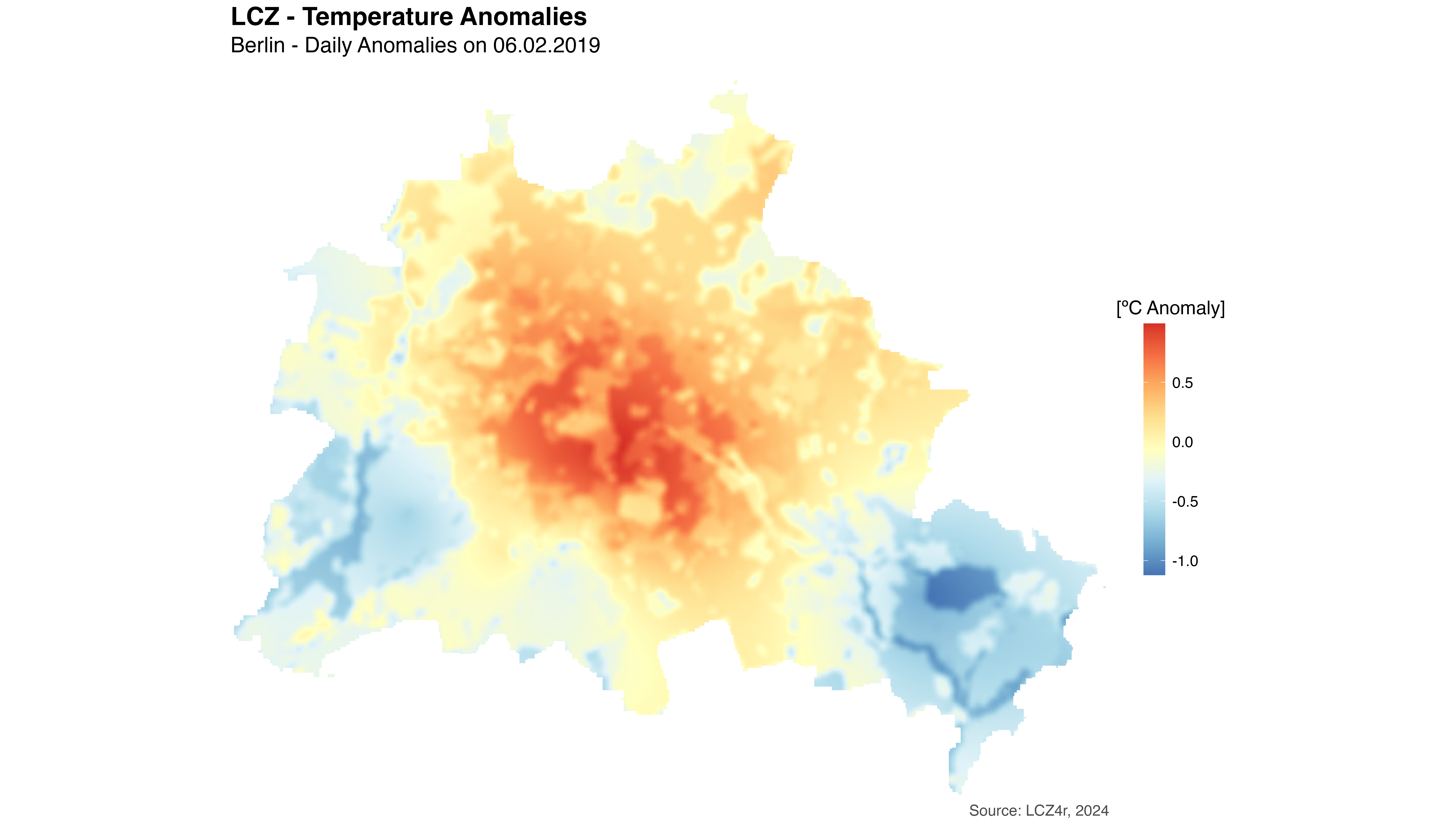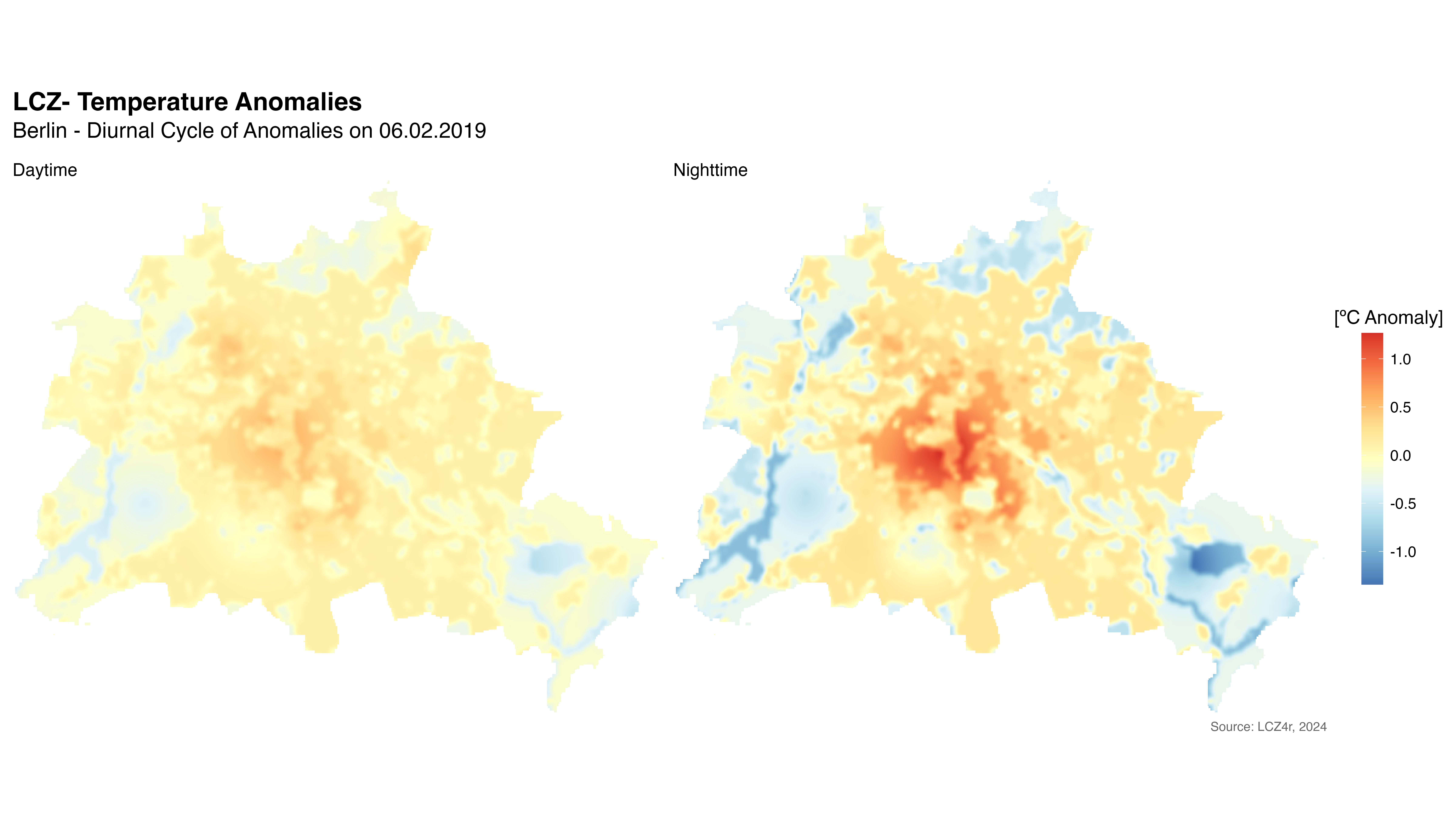Temperature Modeling with LCZ
Max Anjos
October 25, 2025
Source:vignettes/local_func_modeling.Rmd
local_func_modeling.RmdIntroduction
Understanding temperature variations within urban environments is
very important for climate research, particularly when examining Urban
Heat Islands. The LCZ4r package offers functions for creating
interpolated maps and thermal anomaly analyses within Local Climate
Zones (LCZs). lcz_interp_map() or
lcz_anomaly_mapfunctions can be applied to generate
detailed spatial representations of air temperature, allowing
researchers to analyze the influence of urban structures and land use on
local climates.
In this guide, we’ll demonstrate how to use the
lcz_interp_map() or lcz_anomaly_mapfunctions
to model temperature data across Berlin’s LCZ. This will involve
creating maps at specific times, customizing spatial and temporal
resolutions, and visualizing thermal anomalies.
Interpolating with LCZ
The lcz_interp_map() or lcz_anomaly_map()
functions are used to generate a map of interpolated air temperatures.
These functions apply interpolation techniques, like the Kriging model,
to estimate air temperatures based on LCZ classes, enabling a
spatially-resolved understanding of temperature variations. The
parameters for time frequency and data segmentation are consistent with
those used in lcz_ts() and lcz_anomaly(), but
two additional arguments are introduced:
- sp.res: Specifies the spatial resolution of the output map in meters. Default is 100
- tp.res: Defines the time frequency at which values are averaged. Default is hour
The lcz_interp_map() and lcz_anomaly_map()
functions generate either a single raster file or a stack of rasters.
You can visualize the resulting interpolated map using the
lcz_plot_interp() function, creating a clear representation
of air temperature distributions across the selected LCZs.
# Get the LCZ map for your city
lcz_map <- lcz_get_map_euro(city="Berlin")
# Load sample data from LCZ4r
data("lcz_data")Interpolating air temperature
Single hour map interpolation
The following example demonstrates how to generate a temperature map for a specific date and time.
#Mapping air temperatures for 6th February 2019 at 05:00h
my_interp_map <- lcz_interp_map(lcz_map,
data_frame = lcz_data,
var = "airT", station_id = "station",
sp.res = 100, tp.res = "hour",
year = 2019, month = 2, day = 6, hour = 5)
#Customize the plot with titles and labels
lcz_plot_interp(my_interp_map,
title = "LCZ - air temperatures",
subtitle = "Berlin - 06.02.2019 at 05:00",
caption = "Source: LCZ4r, 2024.",
fill = "[ºC]")
Hourly Interpolation Over a Day
The by argument allows you to generate a sequence of hourly temperature maps for a specific day. Here, each hour will be represented by an individual raster layer.
# Active the by argument! Mapping air temperature for each hour
my_interp_map <- lcz_interp_map(lcz_map,
data_frame = lcz_data,
var = "airT", station_id = "station",
sp.res = 100, tp.res = "hour",
year = 2019, month = 2, day = 6,
by = "hour")
#Rename raster names with hour
names(my_interp_map) <- c(1:24)
lcz_plot_interp(my_interp_map,
title = "Hourly LCZ - air temperatures",
subtitle = "Berlin - 06.02.2019",
caption = "Source: LCZ4r, 2024.",
fill = "[ºC]")
Interpolating thermal anomalies
The lcz_anomaly_map() function can be used to highlight
temperature anomalies relative to the average conditions across LCZs.
Anomaly maps are useful in identifying areas where temperatures
significantly differ from typical values, such as heat hotspots within
urban areas.
Single day map interpolation
# Generate an anomaly map for a specified day
my_anomaly_map <- lcz_anomaly_map(lcz_map,
data_frame = lcz_data,
var = "airT", station_id = "station",
sp.res = 100, tp.res = "day",
year = 2019, month = 2, day = 6)
# Plotting the thermal anomaly map
lcz_plot_interp(my_anomaly_map,
title = "LCZ - Temperature Anomalies",
subtitle = "Berlin - Daily Anomalies on 06.02.2019",
caption = "Source: LCZ4r, 2024",
fill = "[Anomaly ºC]",
palette = "bl_yl_rd"
)
Daytime and nighttime anomalies
# Split up anomalies into daytime and nighttime with by="daylight"
my_anomaly_map <- lcz_anomaly_map(lcz_map,
data_frame = lcz_data,
var = "airT", station_id = "station",
sp.res = 100, tp.res = "hour",
year = 2019, month = 2, day = 6,
by = "daylight")
#Rename raster
names(my_anomaly_map) <- c("Daytime", "Nighttime")
# Plotting the thermal anomaly map
lcz_plot_interp(my_anomaly_map,
title = "LCZ- Temperature Anomalies",
subtitle = "Berlin - Diurnal Cycle of Anomalies on 06.02.2019",
caption = "Source: LCZ4r, 2024",
fill = "[ºC Anomaly]",
palette = "bl_yl_rd",
)